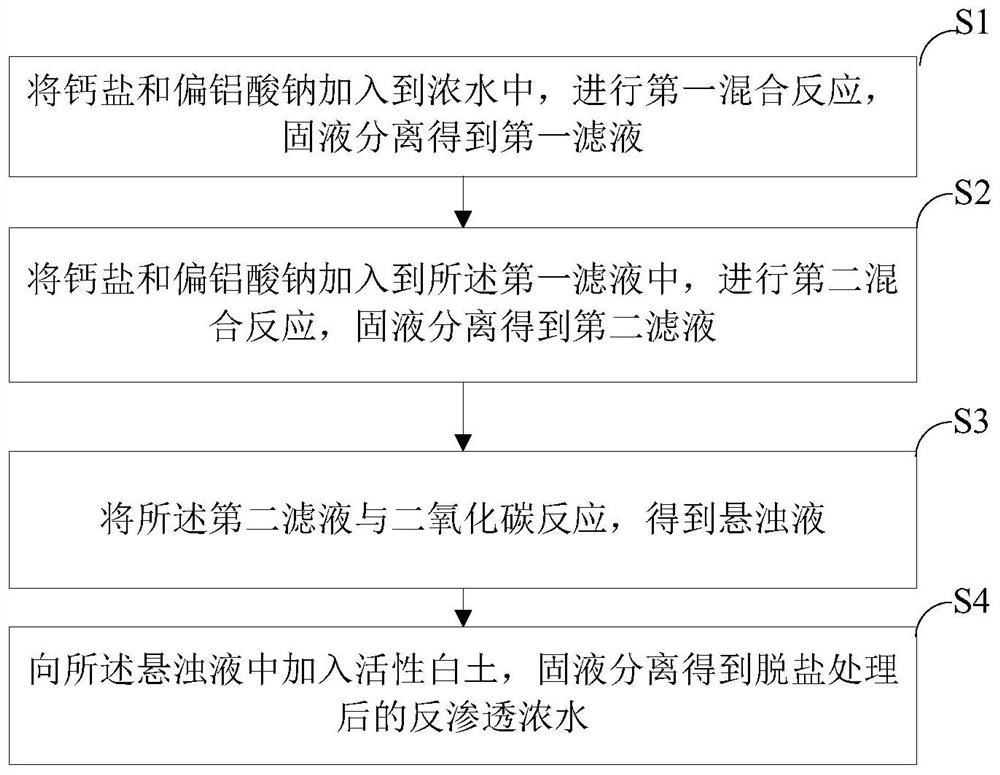Desalination treatment method for reverse osmosis concentrated water
A reverse osmosis concentrated water and treatment method technology, applied in the field of sewage treatment, can solve the problems of acid-base waste liquid, polarization scaling, and complicated operation, so as to reduce scaling ability and corrosion ability, realize recycling, The effect of cheap and easy-to-obtain raw materials
- Summary
- Abstract
- Description
- Claims
- Application Information
AI Technical Summary
Problems solved by technology
Method used
Image
Examples
Embodiment 1
[0055] The concentrated water sample 1 in table 1 is processed as follows:
[0056] (1) Add calcium oxide and sodium metaaluminate to reverse osmosis concentrated water (the molar ratio of calcium oxide, sodium metaaluminate and sulfate ions in the solution is 8:2:1), and stir at 25°C Reaction 120min, suspension is filtered, obtains the filtrate that removes sulfate ion;
[0057] (2) Continue to add calcium oxide and sodium metaaluminate to the filtrate (the molar ratio of calcium oxide, sodium metaaluminate and chloride ions in the solution is 6:2:1), and stir for 120 minutes at 25°C , the suspension is filtered to obtain the filtrate for removing chloride ions;
[0058] (3) Use an air pump to blow air into the filtrate for 2 hours to remove residual calcium and magnesium ions in the solution;
[0059] (4) Add activated clay to the solution according to the addition amount of 50g / L, stir and react for 2h, remove part of the sodium ions in the solution by ion exchange and ne...
Embodiment 2
[0061] The concentrated water sample 1 in table 1 is processed as follows:
[0062] (1) Add calcium hydroxide and sodium metaaluminate to reverse osmosis concentrated water (the molar ratio of calcium hydroxide, sodium metaaluminate and sulfate ions in the solution is 8:2:1), at 25°C , stirring and reacting for 80min, the suspension was filtered to obtain the filtrate for removing sulfate ions;
[0063] (2) Continue to add calcium hydroxide and sodium metaaluminate to the filtrate (the molar ratio of calcium hydroxide, sodium metaaluminate and chloride ions in the solution is 6:2:1), and stir at 25°C After reacting for 80min, the suspension was filtered to obtain the filtrate from which chloride ions were removed;
[0064] (3) Use an air pump to blow air into the filtrate for 3 hours to remove residual calcium and magnesium ions in the solution;
[0065] (4) Add activated clay to the solution according to the addition amount of 50g / L, stir and react for 2h, remove part of th...
Embodiment 3
[0067] The concentrated water sample 1 in table 1 is processed as follows:
[0068] (1) Add calcium oxide and sodium metaaluminate to reverse osmosis concentrated water (the molar ratio of calcium oxide, sodium metaaluminate and sulfate ions in the solution is 10:4:1), and stir at 35°C Reaction 40min, suspension is filtered, obtains the filtrate that removes sulfate ion;
[0069] (2) Continue to add calcium oxide and sodium metaaluminate to the filtrate (the molar ratio of calcium oxide, sodium metaaluminate and chloride ions in the solution is 8:4:1), and stir for 40 minutes at 35°C , the suspension is filtered to obtain the filtrate for removing chloride ions;
[0070] (3) Use an air pump to blow air into the filtrate for 4 hours to remove residual calcium and magnesium ions in the solution;
[0071] (4) Add activated clay to the solution according to the addition amount of 50g / L, stir and react for 2h, remove part of the sodium ions in the solution by ion exchange and neu...
PUM
| Property | Measurement | Unit |
|---|---|---|
| concentration | aaaaa | aaaaa |
| concentration | aaaaa | aaaaa |
Abstract
Description
Claims
Application Information
 Login to View More
Login to View More - R&D
- Intellectual Property
- Life Sciences
- Materials
- Tech Scout
- Unparalleled Data Quality
- Higher Quality Content
- 60% Fewer Hallucinations
Browse by: Latest US Patents, China's latest patents, Technical Efficacy Thesaurus, Application Domain, Technology Topic, Popular Technical Reports.
© 2025 PatSnap. All rights reserved.Legal|Privacy policy|Modern Slavery Act Transparency Statement|Sitemap|About US| Contact US: help@patsnap.com


